
Helicoverpa zea, commonly known as the corn earworm, is a species in the family Noctuidae. The larva of the moth Helicoverpa zea is a major agricultural pest. Since it is polyphagous during the larval stage, the species has been given many different common names, including the cotton bollworm and the tomato fruitworm. It also consumes a wide variety of other crops.

Chalakudy River or Chalakudy Puzha is the fifth longest river in Kerala, India. The river flows through Thrissur district, Palakkad district and Ernakulam district of Kerala. The total drainage area of the river is 1704 km2. Out of this,1404 km2 lies in Kerala and the rest in Tamil Nadu. The length of the river is 145.5 km. Though Chalakudy River in strict geological sense is a tributary of the Periyar river, for all practical purposes it is treated as a separate river by Government and other agencies. The river has gained its name since it flows along the banks of the Chalakudy Town, the major settlement along the course of the river. It is perhaps the most unpolluted and pristine river in the state and even in India due to the limited amount of industries and wastage disposal around it. Chalakudy River and its basin area were one of the most affected rivers during the 2018 Kerala floods.

Heliothis is a genus of moths in the family Noctuidae. It was first described by Ferdinand Ochsenheimer in 1816. Some of the species have larvae which are agricultural pests on crop species such as tobacco, cotton, soybean and pigeon pea. Some species originally in this genus have been moved to other genera, see Chloridea and Helicoverpa.

Heliothis peltigera, also known as the bordered straw, is a species of moth of the family Noctuidae.
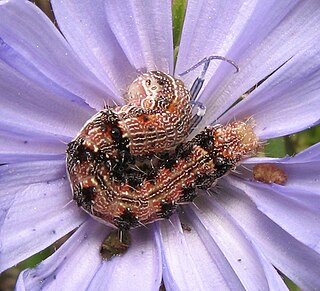
Chloridea is a genus of owlet moths in the family Noctuidae. There are at least three described species in Chloridea.
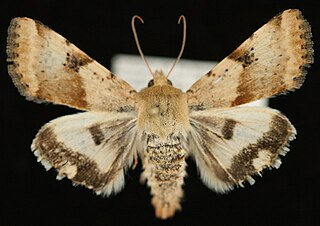
Heliothis phloxiphaga is a species of moth of the family Noctuidae. It is found in the United States and southern Canada. It feeds on a variety of plants, and the caterpillars are considered pests to certain trees, including Ulmus, Malus, and Prunus. Adults are on-wing during the summer.
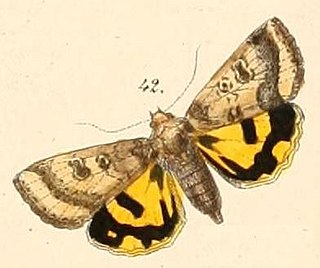
Heliothis acesias is a species of moth of the family Noctuidae. It is found from north-eastern Nevada and southern Idaho, northward to southern Alberta, then eastward to southern and eastern Ontario. Adults are on from June to September.
Heliothis australis is a species of moth of the family Noctuidae. It is found from Chiapas in southern Mexico northward to New Mexico and Arizona. Adults are on wing from May to October.

Heliothis ononis, the flax bollworm, is a moth of the family Noctuidae. The species was first described by Michael Denis and Ignaz Schiffermüller in 1775. It is found in China, Kazakhstan, central Asia, northern Mongolia (Khangai), the Russian Far East, the Korean Peninsula, southern European part of Russia, southern and central Europe, southern and eastern Siberia and Turkey. In North America it is found from south-central Manitoba west to British Columbia, north to the Northwest Territories and Yukon and Alaska and south to Colorado.

Heliothis oregonica, the Oregon gem, is a moth of the family Noctuidae. The species was first described by Henry Edwards in 1875. It is found in North America from the Peace River area of Alberta south and west in the mountains to California and Arizona. There is also a disjunct population in north central Quebec.

Heliothis borealis, the boreal gem, is a moth of the family Noctuidae. The species was first described by George Hampson in 1903. It is found in North America from Quebec west to Alberta, and south in the mountains to south-western Montana.

Heliothis perstriata is a species of moth of the family Noctuidae. It has been recorded from Iran and Punjab in India.

Chloridea subflexa is a moth of the family Noctuidae first described by Achille Guenée in 1852. It is found from most of the United States, throughout the Antilles, and south to Argentina.

Heliothinae is a small, cosmopolitan subfamily of moths in the family Noctuidae, with about 400 described species worldwide. It includes a number of economically significant agricultural pest species, such as Helicoverpa armigera and Helicoverpa zea.
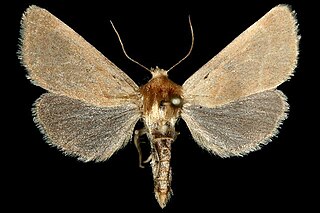
Schinia immaculata is a moth of the family Noctuidae. It is endemic to the area surrounding the Colorado River in the Grand Canyon in Coconino County, Arizona.
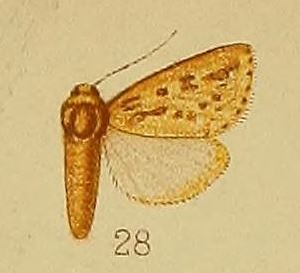
Heliothis albipuncta is a species of moth of the family Noctuidae first described by George Hampson in 1910. It is found in Africa, including South Africa.
Heliothis hoarei is a species of moth of the family Noctuidae. It is endemic to the Northern Territory and Queensland.
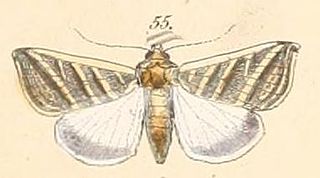
Chloridea tergemina is a species of moth of the family Noctuidae. It is found in South America, including Brazil.

The forest cobra, also commonly called the black cobra and the black and white-lipped cobra, is a species of highly venomous snake in the family Elapidae. The species is native to Africa, mostly the central and western parts of the continent. It is the largest true cobra species with a record length of 3.2 metres.

Diplazium molokaiense is a rare species of fern known by the common name Molokai twinsorus fern. It is endemic to Hawaii, where it is one of the rarest ferns. It has historically been found on the islands of Kauai, Oahu, Lanai, Molokai, and Maui, but it is thought to have been extirpated from four of them and today can be found only on Maui where fewer than 70 individual plants remain. The fern was federally listed as an endangered species of the United States in 1994.













